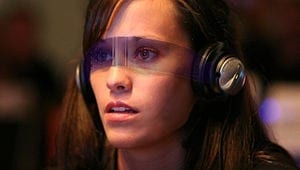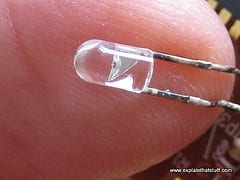
Intel’s Justin Rattner explains why we need new displays and graphics. Tricorders?—Not so much
Google has stoked our collective imagination via relentless promotion of its Google Glass wearable computer in recent months. Thanks to a campaign of Web videos, trade show appearances and blog posts, the search giant has positioned its smartglasses as a hands-free augmented reality gadget that will allow us to share our personal experiences in real time, whether we are skydiving, skiing or handling snakes.
Not surprisingly, a number of competitors have emerged, promising many of the same capabilities. Before augmented-reality eyewear can move into the mainstream, however, Google and its ilk must address some fundamental shortcomings in smartglass technology, including bulky designs, high prices and a dearth of software that would enable them to be more than head-mounted camera phones.
Google should aim for a headset with see-through lenses that allows the wearer to look straight ahead rather than at a small screen off to the side. So says Justin Rattner, a man who, along with his colleagues at chipmaker Intel, spends a lot of time engineering the future of computing technology. Rattner, an Intel Senior Fellow, serves as director of Intel Labs and as the company’s chief technology officer.
Scientific American spoke with him about why smartglasses are getting so much attention, how they should be improved and why Star Trek’s tricorders were a misguided interpretation of the future.
Wearable computers have been around for decades, including ring scanners that factory workers wear on their fingers to read barcodes and even prototype head-mounted units that enable augmented reality. Why is the technology getting so much attention now?
The sensor technology, the communications technology and the computer technology have all reached a point where in some sense for the first time the potential for high-volume consumer wearables is real. That’s what’s new. Today you can put essentially everything that’s in a smartphone into a set of eyeglasses, although they would be a bit heavy. That potentially becomes an interesting platform for communications.
Why do you say “potentially”?
We think there is a grand challenge when it comes to eyewear. No one’s been able to demonstrate a high-performance see-through display. This side-view display that you see in Google Glass and in the Oakley Airwave snow goggles is, in some sense, a recognition of the fact that no one has solved the transparent display problem, even though there are any number of people working on it.
[Such a high-performance see-through display would have] an optical engine for the left and right eyes that would project images into the lenses. The display would be constructed in such a way that it keeps the virtual images in front of you, regardless of where you turn your head or your gaze. It would be a perfect overlay, and you would see right through the projected images. So if you’re doing augmented reality and walking in New York, you will see, “Empire State Building” or “Statue of Liberty” hovering over those physical objects.There’ve been a handful of companies, such as Lumus, that have had these kinds of technologies for a long time, but typically they’ve either been strictly in development or sold for research in augmented reality. Generally speaking, see-through displays have been too bulky, too heavy and too dim to bring to market. They’re fine indoors, but you walk outside and the virtual image is completely washed out.
The Latest Bing News on:
Wearable Computers
- Lovely, Fancy and Expensive: Hands-On With Apple's Newest iPadson May 8, 2024 at 3:00 pm
The iPad Pro is sleeker and smarter, but it's still more of a tablet than a computer replacement. The Pencil Pro, though, has welcome new features.
- COVID-19 pandemic changed attitudes toward wearableson May 8, 2024 at 1:58 pm
A personal connection Cruz is a Ph.D. candidate in computer engineering at Northwestern’s McCormick School of Engineering. In her engineering work, Cruz is particularly interested in building ...
- Ordinary Glasses Could Soon Be Packed with AI, Hologram Tech Thanks to 3D Augmented Realityon May 8, 2024 at 10:14 am
Stanford researchers unveil AR systems using holography & AI, resembling ordinary glasses but offering vibrant 3D visuals.
- COVID-19 pandemic changed attitudes toward wearable health devices, study findson May 8, 2024 at 7:50 am
The COVID-19 pandemic significantly increased interest in wearable health-monitoring devices among low-income Hispanic and Latine adults living in the U.S., a new Northwestern University study has ...
- Huawei introduces Watch Fit 3 as its latest affordable wearableon May 8, 2024 at 4:50 am
Huawei's latest wearable is the squarer designed Watch Fit 3, which looks a lot like another smartwatch currently on the market.
- Whither BCIs?on May 7, 2024 at 6:28 am
Neuralink’s chip is an example of a brain-computer interface (BCI), a system that allows a direct communication pathway between a brain and a computer. In this case, the device needs to be surgically ...
- The incoming wearable recipe, Huawei, Samsung and Apple bring flavouron May 6, 2024 at 12:31 am
The wearable and smartwatch market is poised for some compelling advancements this year, with focus likely going to be around better and more complex health monitoring features.
- Humane Ai Pin and the case for a fourth wearable form factoron May 3, 2024 at 4:32 pm
At the moment, there are two mainstream wearables: smartwatches and headphones. Smart glasses will be a third when display ...
- Taking wearable tech a step furtheron May 3, 2024 at 6:08 am
Thousands of people in Sweden have had microchips surgically implanted under their skin as a new method of payment. CNN's Anna Stewart finds out more about this process, and what future uses it could ...
- Wearable Devices Invited to Present its Gesture Control Technology to Samsung's Senior Management in South Koreaon May 2, 2024 at 1:45 am
At the fair, Wearable Devices will introduce its seamless gesture technology ... offering a seamless interface for interacting with smartphones, computers, and even VR and AR systems. "This ...
The Latest Google Headlines on:
Wearable Computers
[google_news title=”” keyword=”Wearable Computers” num_posts=”10″ blurb_length=”0″ show_thumb=”left”]
The Latest Bing News on:
Smartglasses
- DigiLens Licensee Crystal-Optech Makes Significant Upgrades to Their State-of-the-Art Manufacturing Line to Support a Wave of Global Demandon May 1, 2024 at 9:00 am
DigiLens Inc., a leading nanotechnology innovator in waveguide display technologies and smartglasses, and Crystal-Optech, a leading company in optical integration solutions, announce the completion of ...
- DigiLens Licensee Crystal-Optech Makes Significant Upgrades to Their State-of-the-Art Manufacturing Line to Support a Wave of Global Demandon May 1, 2024 at 2:00 am
as well as demand for DigiLens ARGO™ DigiLens Inc., a leading nanotechnology innovator in waveguide display technologies and smartglasses, and Crystal-Optech, a leading company in optical ...
- Swave Photonics develops true holographic display for spatial computingon April 25, 2024 at 1:00 pm
Swave Photonics, a "true holographic display" company, announced the world’s first 3D holographic display technology for XR.
- Why Llama 3 is changing everything in the world of AIon April 25, 2024 at 10:12 am
Llama 3 isn't just the latest version of Meta's AI -- it's a revolution in capabilities and accessibility. Here's why it could be the big AI of the future.
- AI-Powered Sonar on Smartglasses Promises to Monitor Gaze and Facial Expressionson April 10, 2024 at 9:05 pm
These advancements, suitable for integration into commercial smartglasses or virtual reality (VR) and augmented reality (AR) headsets, offer a distinct advantage over camera-based systems by ...
- AI-powered 'sonar' on smartglasses tracks gaze, facial expressionson April 10, 2024 at 12:27 pm
The technology is small enough to fit on commercial smartglasses or virtual reality or augmented reality headsets yet consumes significantly less power than similar tools using cameras.
- AI-powered ‘sonar’ on smartglasses tracks gaze, facial expressionson April 9, 2024 at 5:00 pm
The technology is small enough to fit on commercial smartglasses or virtual reality or augmented reality headsets, yet consumes significantly less power than similar tools using cameras.
- The 10 most exciting new products unveiled at CES 2021on April 1, 2024 at 5:00 pm
That’s where Bosch Sensortec comes in — as you’ll see in the video above, Bosch Smartglasses Light Drive is the smart glasses tech we’ve been waiting for, enabling the stunning augmented r ...
- 6 Solid Choices For AR Smartglasses, The Must-Have Geek Gift Of 2023on December 19, 2023 at 3:46 pm
A former tech executive covering AI, XR and The Metaverse for Forbes. Priced from $349 to $600, six new video smartglasses from six different companies were introduced this fall, just in time for ...
- TCL’s Nxtwear S, A New Take On AR Smartglasseson September 28, 2023 at 3:00 am
A former tech executive covering AI, XR and The Metaverse for Forbes. TCL's $349 Nxtwear S AR smartglasses is a big step up from their $200 G model. The S projects what appears to be a 130 inch ...
The Latest Google Headlines on:
Smartglasses
[google_news title=”” keyword=”smartglasses” num_posts=”10″ blurb_length=”0″ show_thumb=”left”]










